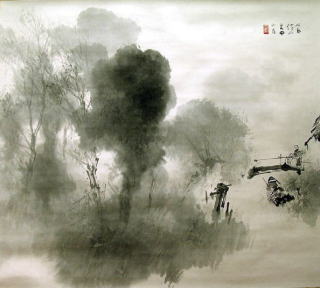Suibokuga, or ink painting which is expressed only using black sumi ink on a white background, may be considered by significant numbers of people as sober and boring compared to multicolor paintings. In China, however, ink has been considered as being capable to substitute 5 colors since ancient times. As if to prove that, there are examples of works which give strong impressions to viewers as being richly colored paintings through the comparison and fusion of thin and dark inks, and the differences between strong and weak brush strokes.
This exhibition consists of 3 sections: “Expression of Lines,” ”Expression as Surface, such as Bleeding,” and “Japanese Paintings with Ink as the Key Color” – and introduces works done by only ink, ink and colors, and color paintings practicing the techniques of ink painting.
Kobayashi Kokei’s Sotatsu is a monochrome painting rendered with tense and beautiful lines of ink, while a pair of paintings, Rakan Ryūko, by Ogawa Usen are filled with bold, free and easy lines producing a playful atmosphere. Subtle and profound landscapes utilizing the effect of bleeding of ink are creations of Yokoyama Taikan and Takeuchi Seihō, the two masters of Tokyo and Kyoto circles of Japanese painting who also actively practiced ink paintings. The works of Kondō Kōichiro, who started his carrier in Western painting and broke new ground by his Impressioinist-like ink painting; Kosugi Hōan’s simple and refined works achieved by dry brushstrokes; and other examples of Japanese paintings colored with shin colors and tarashikomi method are also exhibited.
Have a nice conversation with the various colors of ink exposed in the contrasts of brushwork and the different intensities of ink.
※Due to measures to prevent the spread of COVID-19, this exhibition is rescheduled in the next year, 2021. The schedule has not been announced yet.(6/24/20)
